BUACC5932 - Corporate Accounting: Qantas Airways Financial Analysis
VerifiedAdded on 2023/06/06
|12
|2759
|476
Report
AI Summary
This report provides a detailed analysis of Qantas Airways Limited's business operations, financial performance, and capital structure, based on its 2018 annual report. It covers various aspects including the company's overview, industry position, capital structure management, key financial elements (assets, liabilities, equity, revenue, expenses), and subsequent events. The report also discusses changes in accounting policies, focusing on the adoption of AASB 9, AASB 15, and AASB 16. A significant portion is dedicated to the analysis of tangible (property, plant, and equipment) and intangible assets, including their carrying amounts, accounting policies (AASB 116 and AASB 138), and impairment losses. The report concludes that Qantas Airways Limited's financial statements and accounting treatments align with Australian Accounting Standards, while noting some presentation deficiencies in the annual report regarding the separate disclosure of impairment losses.
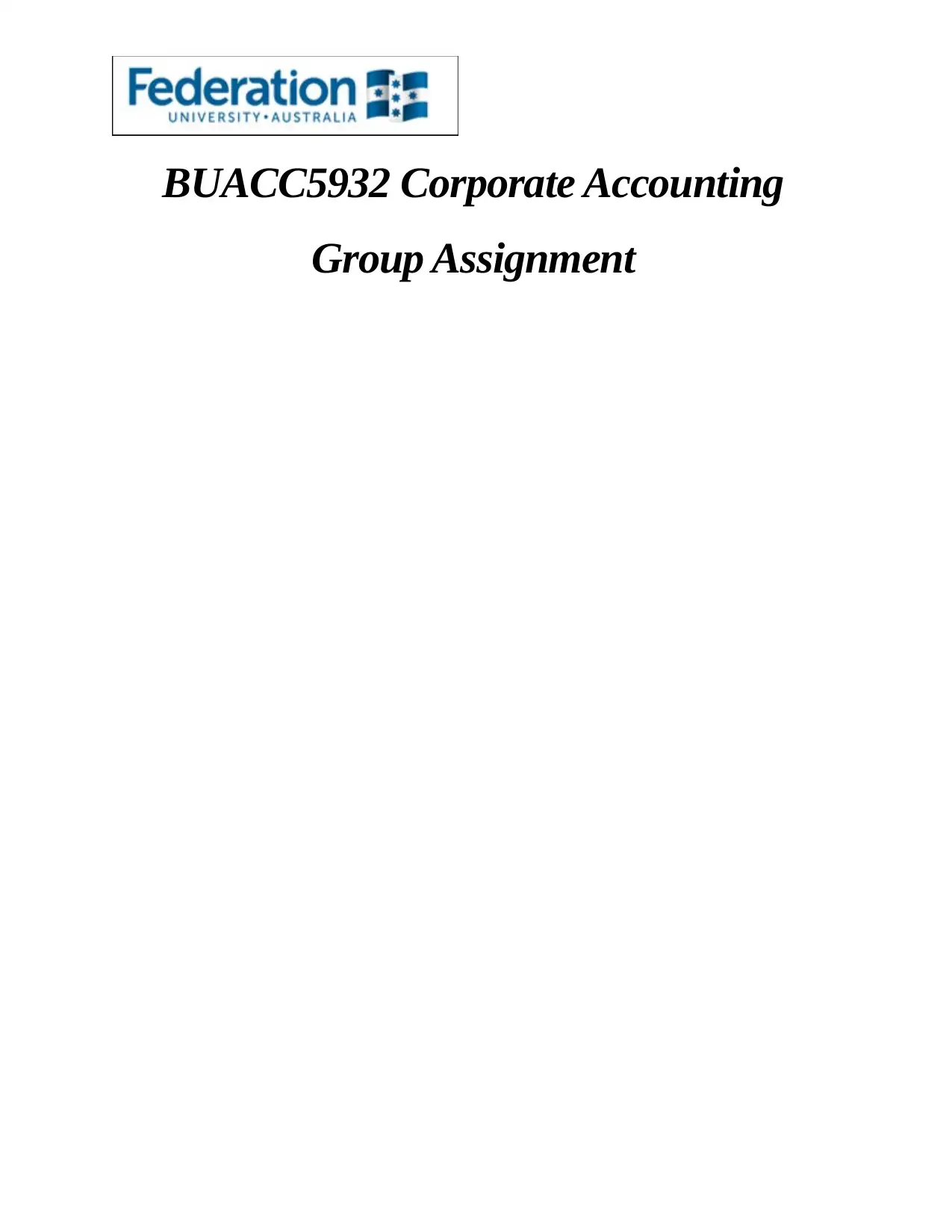
BUACC5932 Corporate Accounting
Group Assignment
Group Assignment
Paraphrase This Document
Need a fresh take? Get an instant paraphrase of this document with our AI Paraphraser
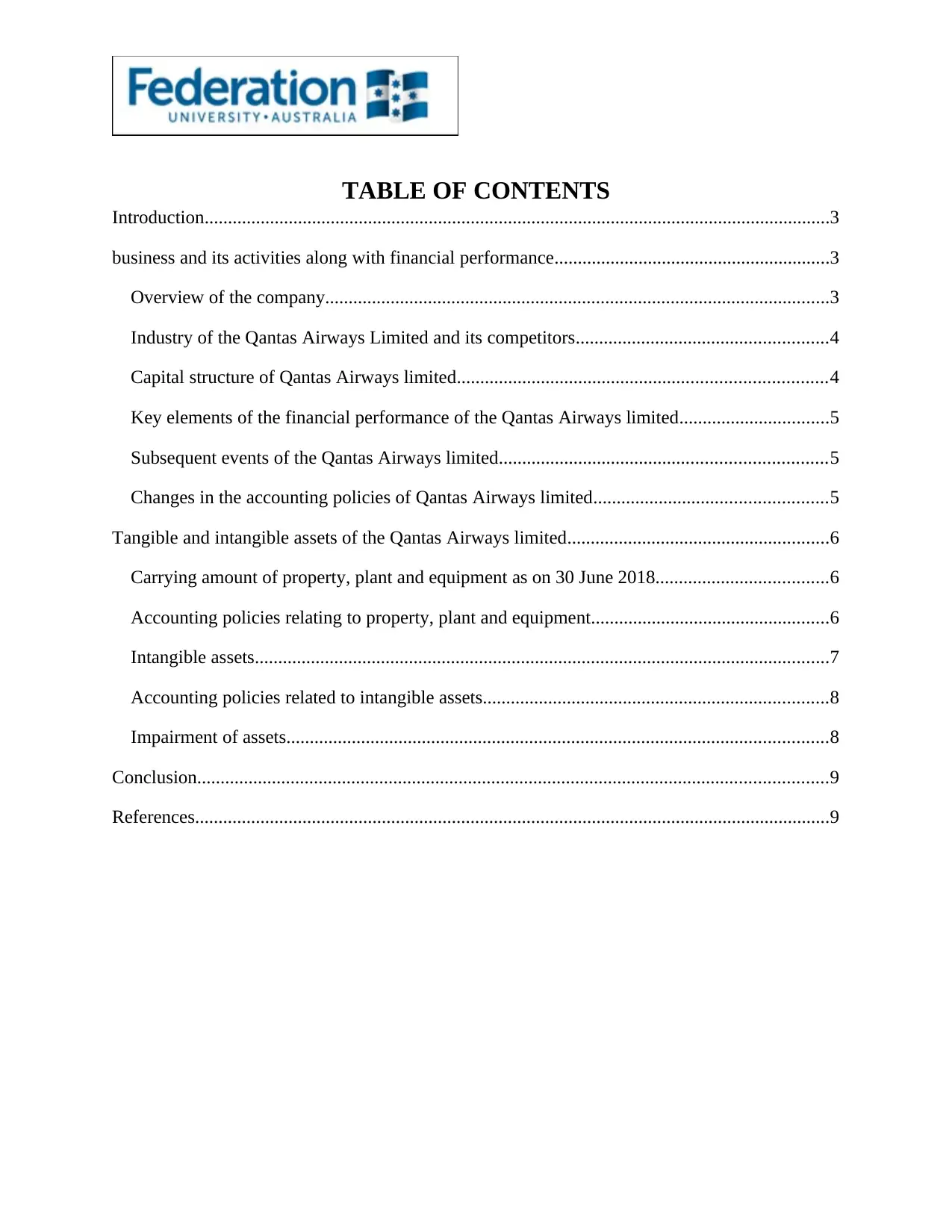
TABLE OF CONTENTS
Introduction......................................................................................................................................3
business and its activities along with financial performance...........................................................3
Overview of the company............................................................................................................3
Industry of the Qantas Airways Limited and its competitors......................................................4
Capital structure of Qantas Airways limited...............................................................................4
Key elements of the financial performance of the Qantas Airways limited................................5
Subsequent events of the Qantas Airways limited......................................................................5
Changes in the accounting policies of Qantas Airways limited..................................................5
Tangible and intangible assets of the Qantas Airways limited........................................................6
Carrying amount of property, plant and equipment as on 30 June 2018.....................................6
Accounting policies relating to property, plant and equipment...................................................6
Intangible assets...........................................................................................................................7
Accounting policies related to intangible assets..........................................................................8
Impairment of assets....................................................................................................................8
Conclusion.......................................................................................................................................9
References........................................................................................................................................9
Introduction......................................................................................................................................3
business and its activities along with financial performance...........................................................3
Overview of the company............................................................................................................3
Industry of the Qantas Airways Limited and its competitors......................................................4
Capital structure of Qantas Airways limited...............................................................................4
Key elements of the financial performance of the Qantas Airways limited................................5
Subsequent events of the Qantas Airways limited......................................................................5
Changes in the accounting policies of Qantas Airways limited..................................................5
Tangible and intangible assets of the Qantas Airways limited........................................................6
Carrying amount of property, plant and equipment as on 30 June 2018.....................................6
Accounting policies relating to property, plant and equipment...................................................6
Intangible assets...........................................................................................................................7
Accounting policies related to intangible assets..........................................................................8
Impairment of assets....................................................................................................................8
Conclusion.......................................................................................................................................9
References........................................................................................................................................9
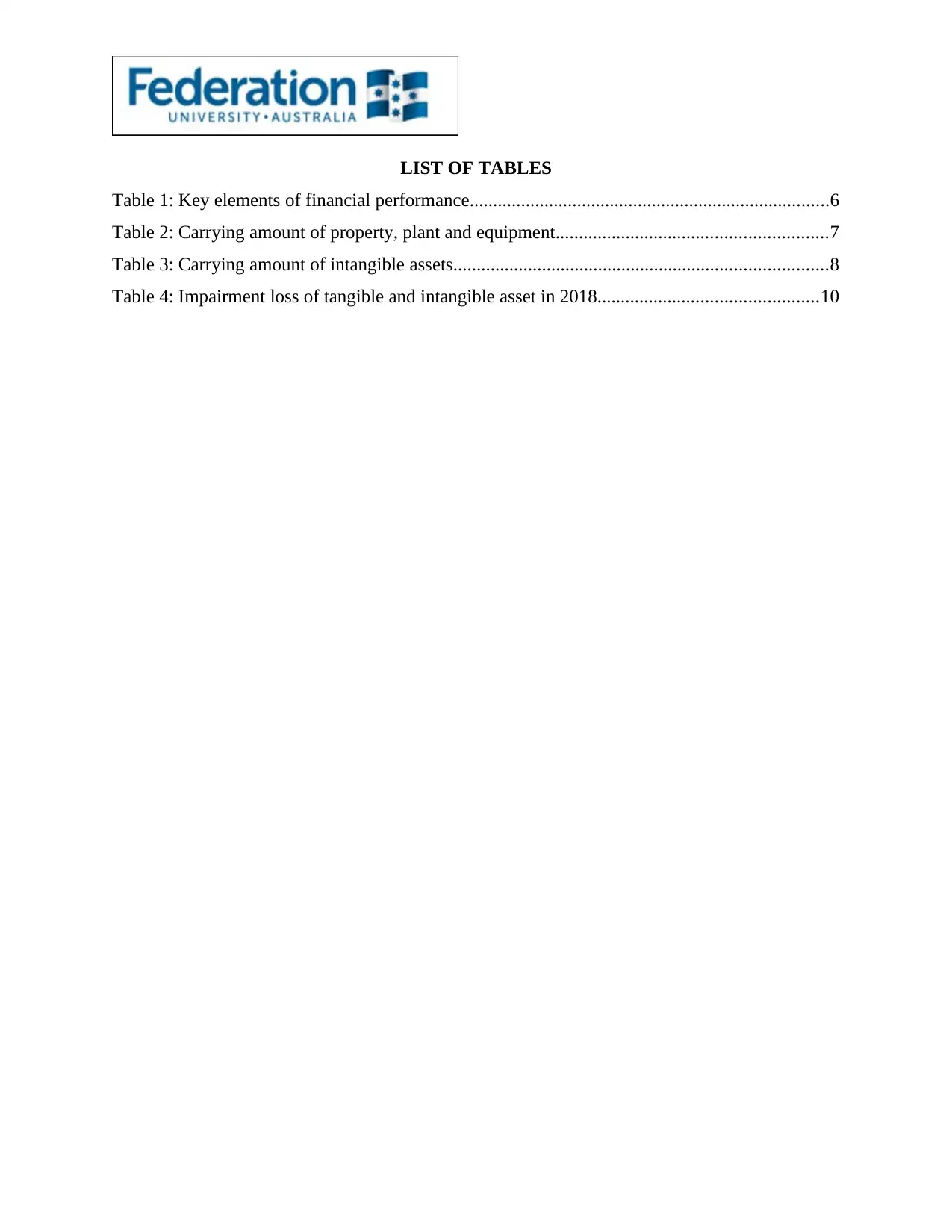
LIST OF TABLES
Table 1: Key elements of financial performance.............................................................................6
Table 2: Carrying amount of property, plant and equipment..........................................................7
Table 3: Carrying amount of intangible assets................................................................................8
Table 4: Impairment loss of tangible and intangible asset in 2018...............................................10
Table 1: Key elements of financial performance.............................................................................6
Table 2: Carrying amount of property, plant and equipment..........................................................7
Table 3: Carrying amount of intangible assets................................................................................8
Table 4: Impairment loss of tangible and intangible asset in 2018...............................................10
⊘ This is a preview!⊘
Do you want full access?
Subscribe today to unlock all pages.

Trusted by 1+ million students worldwide

INTRODUCTION
The present study is based on the analyses of the business operations and the activities along
with the financial performance and the capital structure of the Qantas Airways limited.
BUSINESS AND ITS ACTIVITIES ALONG WITH FINANCIAL
PERFORMANCE
Overview of the company
Qantas was established in 1920, in the Queensland (Australia), and at present it is considered as a
prevalent domestic as well as international airline of Australia, and the third oldest airline of the
world. Reputation and the brand image of the company have been increased significantly due to
the superiority in safety, operational reliability, engineering and maintenance and the customer
services (Shaffner, Mills, and Mills, 2017). The main operation of the company is providing
transportation services to the customers, further for facilitating the airline transportation service
company is using two complementary airlines brands such as Qantas and Jetstar.
The company is consisting of different operating segments, and all operating segments of the
company are working together as a combined portfolio. The different segments of the company
are enumerated as below-
a) Qantas Domestic- it is the major transportation of the Domestic Australian market and
has above 40% market share measured by capacity. This segment of the company by its
brand, network and product, target the business and premium class customers who give
value for the full-service experience. Further for increasing the customer satisfaction, this
segment continues in investing in onboard Wi-Fi rollout underway and also developing
the domestic lounges.
b) Qantas international- it provides the major transportation services in Australia and out of
Australia, and also targeting the business class and the premium class customers who
value the services.
The present study is based on the analyses of the business operations and the activities along
with the financial performance and the capital structure of the Qantas Airways limited.
BUSINESS AND ITS ACTIVITIES ALONG WITH FINANCIAL
PERFORMANCE
Overview of the company
Qantas was established in 1920, in the Queensland (Australia), and at present it is considered as a
prevalent domestic as well as international airline of Australia, and the third oldest airline of the
world. Reputation and the brand image of the company have been increased significantly due to
the superiority in safety, operational reliability, engineering and maintenance and the customer
services (Shaffner, Mills, and Mills, 2017). The main operation of the company is providing
transportation services to the customers, further for facilitating the airline transportation service
company is using two complementary airlines brands such as Qantas and Jetstar.
The company is consisting of different operating segments, and all operating segments of the
company are working together as a combined portfolio. The different segments of the company
are enumerated as below-
a) Qantas Domestic- it is the major transportation of the Domestic Australian market and
has above 40% market share measured by capacity. This segment of the company by its
brand, network and product, target the business and premium class customers who give
value for the full-service experience. Further for increasing the customer satisfaction, this
segment continues in investing in onboard Wi-Fi rollout underway and also developing
the domestic lounges.
b) Qantas international- it provides the major transportation services in Australia and out of
Australia, and also targeting the business class and the premium class customers who
value the services.
Paraphrase This Document
Need a fresh take? Get an instant paraphrase of this document with our AI Paraphraser
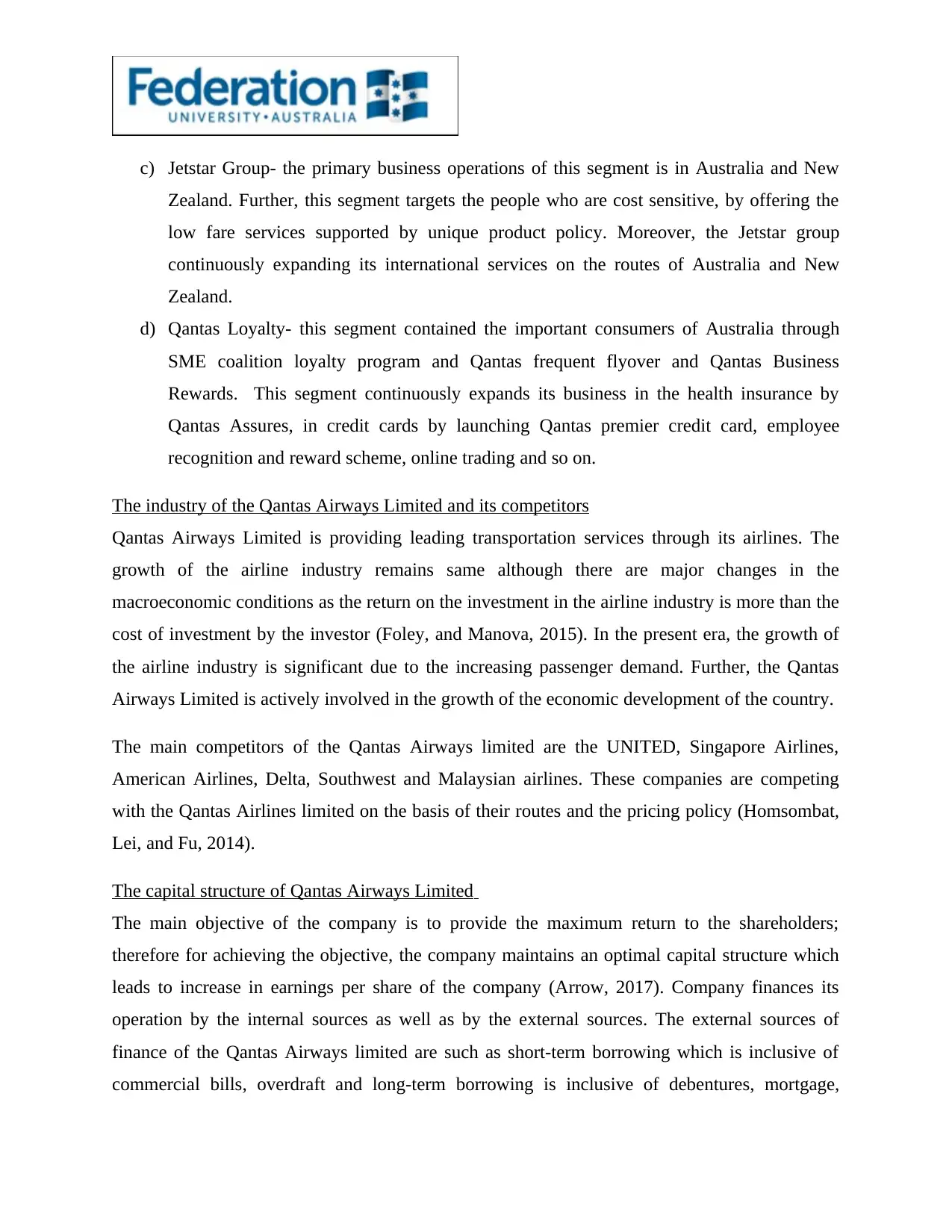
c) Jetstar Group- the primary business operations of this segment is in Australia and New
Zealand. Further, this segment targets the people who are cost sensitive, by offering the
low fare services supported by unique product policy. Moreover, the Jetstar group
continuously expanding its international services on the routes of Australia and New
Zealand.
d) Qantas Loyalty- this segment contained the important consumers of Australia through
SME coalition loyalty program and Qantas frequent flyover and Qantas Business
Rewards. This segment continuously expands its business in the health insurance by
Qantas Assures, in credit cards by launching Qantas premier credit card, employee
recognition and reward scheme, online trading and so on.
The industry of the Qantas Airways Limited and its competitors
Qantas Airways Limited is providing leading transportation services through its airlines. The
growth of the airline industry remains same although there are major changes in the
macroeconomic conditions as the return on the investment in the airline industry is more than the
cost of investment by the investor (Foley, and Manova, 2015). In the present era, the growth of
the airline industry is significant due to the increasing passenger demand. Further, the Qantas
Airways Limited is actively involved in the growth of the economic development of the country.
The main competitors of the Qantas Airways limited are the UNITED, Singapore Airlines,
American Airlines, Delta, Southwest and Malaysian airlines. These companies are competing
with the Qantas Airlines limited on the basis of their routes and the pricing policy (Homsombat,
Lei, and Fu, 2014).
The capital structure of Qantas Airways Limited
The main objective of the company is to provide the maximum return to the shareholders;
therefore for achieving the objective, the company maintains an optimal capital structure which
leads to increase in earnings per share of the company (Arrow, 2017). Company finances its
operation by the internal sources as well as by the external sources. The external sources of
finance of the Qantas Airways limited are such as short-term borrowing which is inclusive of
commercial bills, overdraft and long-term borrowing is inclusive of debentures, mortgage,
Zealand. Further, this segment targets the people who are cost sensitive, by offering the
low fare services supported by unique product policy. Moreover, the Jetstar group
continuously expanding its international services on the routes of Australia and New
Zealand.
d) Qantas Loyalty- this segment contained the important consumers of Australia through
SME coalition loyalty program and Qantas frequent flyover and Qantas Business
Rewards. This segment continuously expands its business in the health insurance by
Qantas Assures, in credit cards by launching Qantas premier credit card, employee
recognition and reward scheme, online trading and so on.
The industry of the Qantas Airways Limited and its competitors
Qantas Airways Limited is providing leading transportation services through its airlines. The
growth of the airline industry remains same although there are major changes in the
macroeconomic conditions as the return on the investment in the airline industry is more than the
cost of investment by the investor (Foley, and Manova, 2015). In the present era, the growth of
the airline industry is significant due to the increasing passenger demand. Further, the Qantas
Airways Limited is actively involved in the growth of the economic development of the country.
The main competitors of the Qantas Airways limited are the UNITED, Singapore Airlines,
American Airlines, Delta, Southwest and Malaysian airlines. These companies are competing
with the Qantas Airlines limited on the basis of their routes and the pricing policy (Homsombat,
Lei, and Fu, 2014).
The capital structure of Qantas Airways Limited
The main objective of the company is to provide the maximum return to the shareholders;
therefore for achieving the objective, the company maintains an optimal capital structure which
leads to increase in earnings per share of the company (Arrow, 2017). Company finances its
operation by the internal sources as well as by the external sources. The external sources of
finance of the Qantas Airways limited are such as short-term borrowing which is inclusive of
commercial bills, overdraft and long-term borrowing is inclusive of debentures, mortgage,
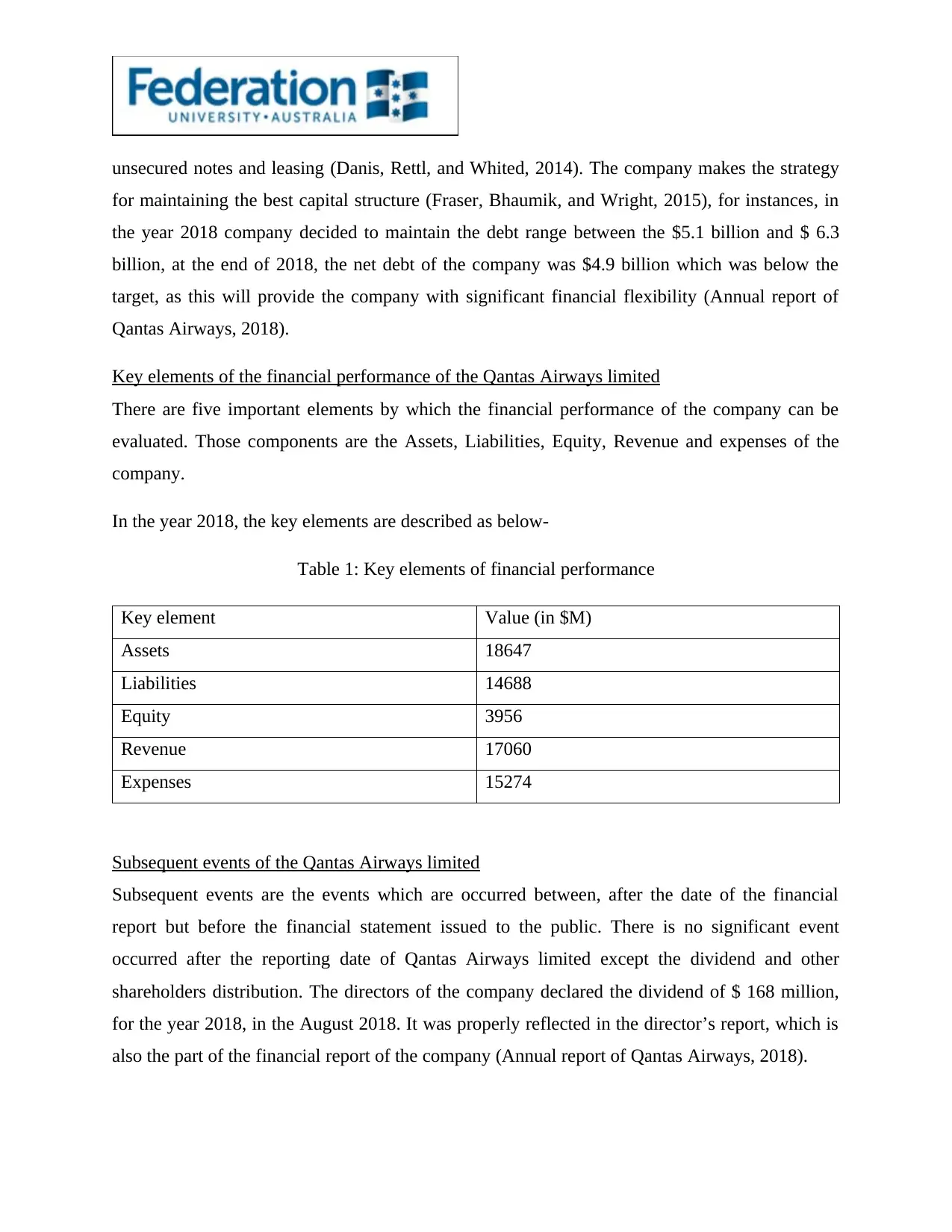
unsecured notes and leasing (Danis, Rettl, and Whited, 2014). The company makes the strategy
for maintaining the best capital structure (Fraser, Bhaumik, and Wright, 2015), for instances, in
the year 2018 company decided to maintain the debt range between the $5.1 billion and $ 6.3
billion, at the end of 2018, the net debt of the company was $4.9 billion which was below the
target, as this will provide the company with significant financial flexibility (Annual report of
Qantas Airways, 2018).
Key elements of the financial performance of the Qantas Airways limited
There are five important elements by which the financial performance of the company can be
evaluated. Those components are the Assets, Liabilities, Equity, Revenue and expenses of the
company.
In the year 2018, the key elements are described as below-
Table 1: Key elements of financial performance
Key element Value (in $M)
Assets 18647
Liabilities 14688
Equity 3956
Revenue 17060
Expenses 15274
Subsequent events of the Qantas Airways limited
Subsequent events are the events which are occurred between, after the date of the financial
report but before the financial statement issued to the public. There is no significant event
occurred after the reporting date of Qantas Airways limited except the dividend and other
shareholders distribution. The directors of the company declared the dividend of $ 168 million,
for the year 2018, in the August 2018. It was properly reflected in the director’s report, which is
also the part of the financial report of the company (Annual report of Qantas Airways, 2018).
for maintaining the best capital structure (Fraser, Bhaumik, and Wright, 2015), for instances, in
the year 2018 company decided to maintain the debt range between the $5.1 billion and $ 6.3
billion, at the end of 2018, the net debt of the company was $4.9 billion which was below the
target, as this will provide the company with significant financial flexibility (Annual report of
Qantas Airways, 2018).
Key elements of the financial performance of the Qantas Airways limited
There are five important elements by which the financial performance of the company can be
evaluated. Those components are the Assets, Liabilities, Equity, Revenue and expenses of the
company.
In the year 2018, the key elements are described as below-
Table 1: Key elements of financial performance
Key element Value (in $M)
Assets 18647
Liabilities 14688
Equity 3956
Revenue 17060
Expenses 15274
Subsequent events of the Qantas Airways limited
Subsequent events are the events which are occurred between, after the date of the financial
report but before the financial statement issued to the public. There is no significant event
occurred after the reporting date of Qantas Airways limited except the dividend and other
shareholders distribution. The directors of the company declared the dividend of $ 168 million,
for the year 2018, in the August 2018. It was properly reflected in the director’s report, which is
also the part of the financial report of the company (Annual report of Qantas Airways, 2018).
⊘ This is a preview!⊘
Do you want full access?
Subscribe today to unlock all pages.

Trusted by 1+ million students worldwide
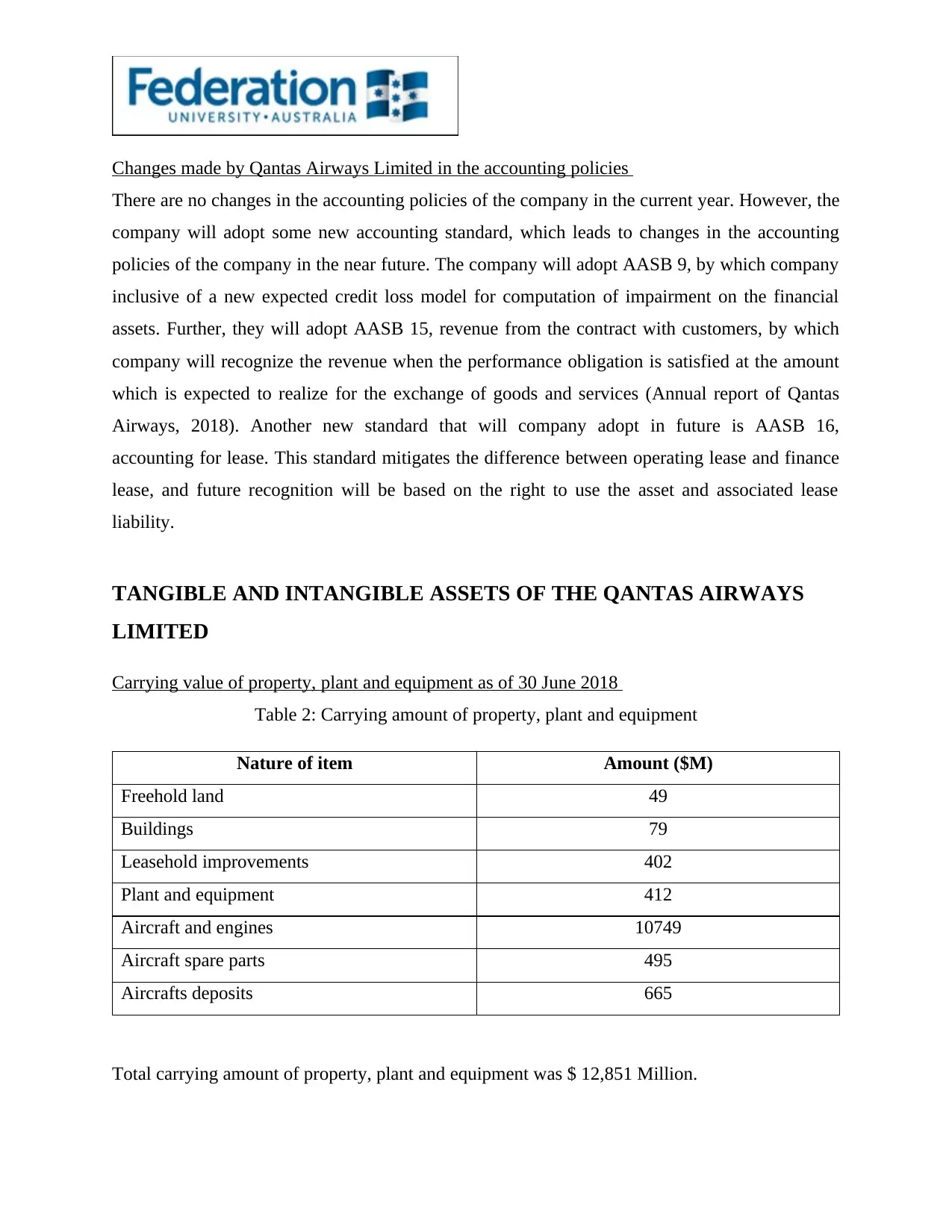
Changes made by Qantas Airways Limited in the accounting policies
There are no changes in the accounting policies of the company in the current year. However, the
company will adopt some new accounting standard, which leads to changes in the accounting
policies of the company in the near future. The company will adopt AASB 9, by which company
inclusive of a new expected credit loss model for computation of impairment on the financial
assets. Further, they will adopt AASB 15, revenue from the contract with customers, by which
company will recognize the revenue when the performance obligation is satisfied at the amount
which is expected to realize for the exchange of goods and services (Annual report of Qantas
Airways, 2018). Another new standard that will company adopt in future is AASB 16,
accounting for lease. This standard mitigates the difference between operating lease and finance
lease, and future recognition will be based on the right to use the asset and associated lease
liability.
TANGIBLE AND INTANGIBLE ASSETS OF THE QANTAS AIRWAYS
LIMITED
Carrying value of property, plant and equipment as of 30 June 2018
Table 2: Carrying amount of property, plant and equipment
Nature of item Amount ($M)
Freehold land 49
Buildings 79
Leasehold improvements 402
Plant and equipment 412
Aircraft and engines 10749
Aircraft spare parts 495
Aircrafts deposits 665
Total carrying amount of property, plant and equipment was $ 12,851 Million.
There are no changes in the accounting policies of the company in the current year. However, the
company will adopt some new accounting standard, which leads to changes in the accounting
policies of the company in the near future. The company will adopt AASB 9, by which company
inclusive of a new expected credit loss model for computation of impairment on the financial
assets. Further, they will adopt AASB 15, revenue from the contract with customers, by which
company will recognize the revenue when the performance obligation is satisfied at the amount
which is expected to realize for the exchange of goods and services (Annual report of Qantas
Airways, 2018). Another new standard that will company adopt in future is AASB 16,
accounting for lease. This standard mitigates the difference between operating lease and finance
lease, and future recognition will be based on the right to use the asset and associated lease
liability.
TANGIBLE AND INTANGIBLE ASSETS OF THE QANTAS AIRWAYS
LIMITED
Carrying value of property, plant and equipment as of 30 June 2018
Table 2: Carrying amount of property, plant and equipment
Nature of item Amount ($M)
Freehold land 49
Buildings 79
Leasehold improvements 402
Plant and equipment 412
Aircraft and engines 10749
Aircraft spare parts 495
Aircrafts deposits 665
Total carrying amount of property, plant and equipment was $ 12,851 Million.
Paraphrase This Document
Need a fresh take? Get an instant paraphrase of this document with our AI Paraphraser
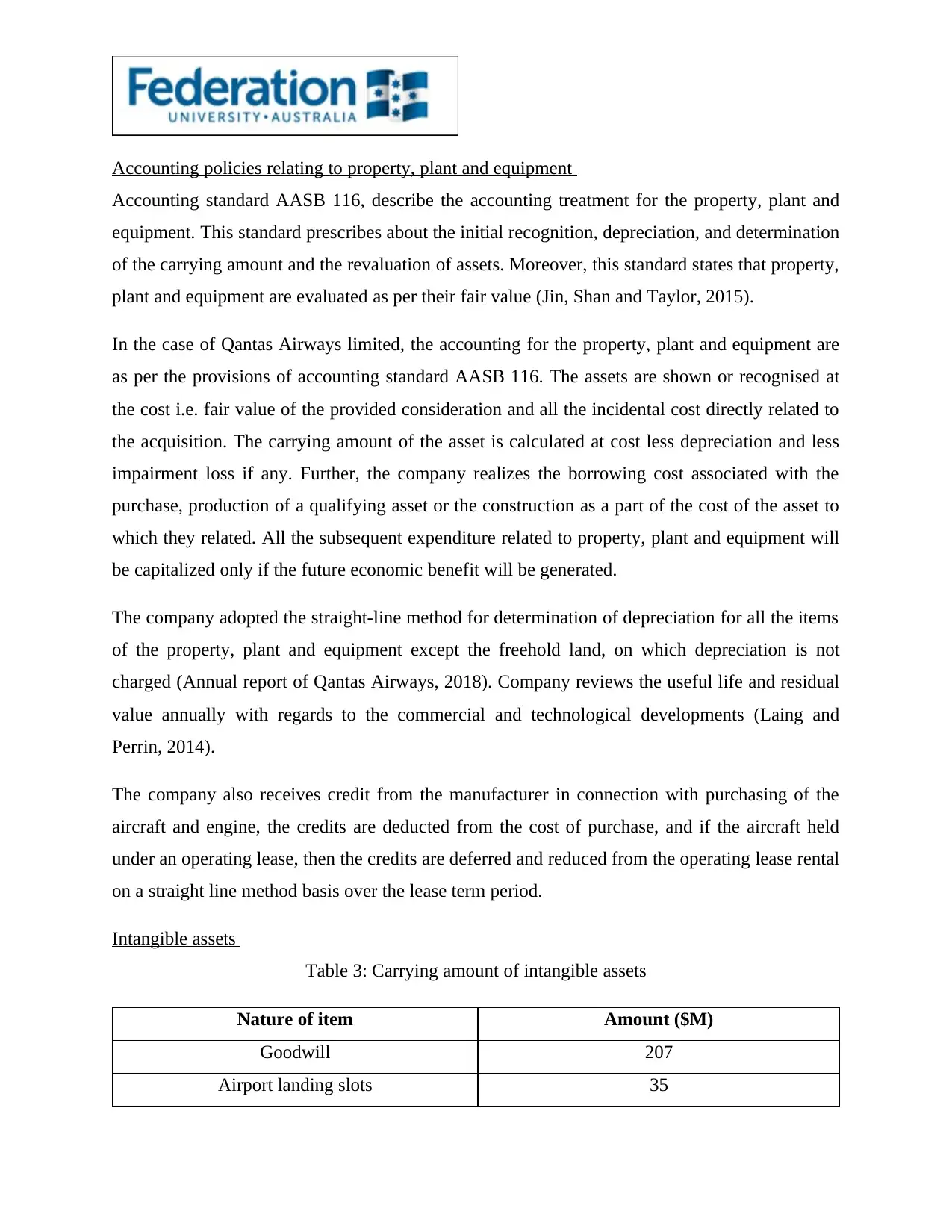
Accounting policies relating to property, plant and equipment
Accounting standard AASB 116, describe the accounting treatment for the property, plant and
equipment. This standard prescribes about the initial recognition, depreciation, and determination
of the carrying amount and the revaluation of assets. Moreover, this standard states that property,
plant and equipment are evaluated as per their fair value (Jin, Shan and Taylor, 2015).
In the case of Qantas Airways limited, the accounting for the property, plant and equipment are
as per the provisions of accounting standard AASB 116. The assets are shown or recognised at
the cost i.e. fair value of the provided consideration and all the incidental cost directly related to
the acquisition. The carrying amount of the asset is calculated at cost less depreciation and less
impairment loss if any. Further, the company realizes the borrowing cost associated with the
purchase, production of a qualifying asset or the construction as a part of the cost of the asset to
which they related. All the subsequent expenditure related to property, plant and equipment will
be capitalized only if the future economic benefit will be generated.
The company adopted the straight-line method for determination of depreciation for all the items
of the property, plant and equipment except the freehold land, on which depreciation is not
charged (Annual report of Qantas Airways, 2018). Company reviews the useful life and residual
value annually with regards to the commercial and technological developments (Laing and
Perrin, 2014).
The company also receives credit from the manufacturer in connection with purchasing of the
aircraft and engine, the credits are deducted from the cost of purchase, and if the aircraft held
under an operating lease, then the credits are deferred and reduced from the operating lease rental
on a straight line method basis over the lease term period.
Intangible assets
Table 3: Carrying amount of intangible assets
Nature of item Amount ($M)
Goodwill 207
Airport landing slots 35
Accounting standard AASB 116, describe the accounting treatment for the property, plant and
equipment. This standard prescribes about the initial recognition, depreciation, and determination
of the carrying amount and the revaluation of assets. Moreover, this standard states that property,
plant and equipment are evaluated as per their fair value (Jin, Shan and Taylor, 2015).
In the case of Qantas Airways limited, the accounting for the property, plant and equipment are
as per the provisions of accounting standard AASB 116. The assets are shown or recognised at
the cost i.e. fair value of the provided consideration and all the incidental cost directly related to
the acquisition. The carrying amount of the asset is calculated at cost less depreciation and less
impairment loss if any. Further, the company realizes the borrowing cost associated with the
purchase, production of a qualifying asset or the construction as a part of the cost of the asset to
which they related. All the subsequent expenditure related to property, plant and equipment will
be capitalized only if the future economic benefit will be generated.
The company adopted the straight-line method for determination of depreciation for all the items
of the property, plant and equipment except the freehold land, on which depreciation is not
charged (Annual report of Qantas Airways, 2018). Company reviews the useful life and residual
value annually with regards to the commercial and technological developments (Laing and
Perrin, 2014).
The company also receives credit from the manufacturer in connection with purchasing of the
aircraft and engine, the credits are deducted from the cost of purchase, and if the aircraft held
under an operating lease, then the credits are deferred and reduced from the operating lease rental
on a straight line method basis over the lease term period.
Intangible assets
Table 3: Carrying amount of intangible assets
Nature of item Amount ($M)
Goodwill 207
Airport landing slots 35

Software 757
Brand names and trademarks 26
Customer contracts/relationships 1
Contract intangible assets 87
Total intangible assets of the company $1113 Million.
Accounting policies related to intangible assets
Accounting standard AASB 138, deals with the intangible assets. An intangible asset is
recognized only if they can generate the future economic benefit and the cost of the asset can be
measured reliably. Cost of the intangible assets comprises with all cost which is directly
attributable to the intangible assets (Su and Wells, 2018).
The company recognizes the goodwill at cost after deducting the impairment loss if any. Further
under the equity method, with respect to investment, the carrying amount of goodwill is covered
under value of shown investment.
Airport landing slots in financial statements are shown at cost less any impairment loss and same
provisions has been applied for accounting of the software, Contract intangible assets Brand
names and trademarks. As it is also stated at cost less accumulated amortization and any
impairment loss, and software development cost is recognized as assets only if the future
economic benefit can be generated and the cost can be reliably measured. Customer contracts
and relationship stated at their fair value at the time of acquisition and less accumulated
amortization and impairment loss (Annual report of Qantas Airways, 2018). Further,
amortization will be charged when the asset is in ready to use condition.
Goodwill, brand names and trademark have indefinite lives; therefore they are not amortized by
the company. Apart from these assets, remaining assets are amortized to write off the cost of the
intangible asset after deducting their residual value over the life of assets (Steenkamp, and
Steenkamp, 2016).
Brand names and trademarks 26
Customer contracts/relationships 1
Contract intangible assets 87
Total intangible assets of the company $1113 Million.
Accounting policies related to intangible assets
Accounting standard AASB 138, deals with the intangible assets. An intangible asset is
recognized only if they can generate the future economic benefit and the cost of the asset can be
measured reliably. Cost of the intangible assets comprises with all cost which is directly
attributable to the intangible assets (Su and Wells, 2018).
The company recognizes the goodwill at cost after deducting the impairment loss if any. Further
under the equity method, with respect to investment, the carrying amount of goodwill is covered
under value of shown investment.
Airport landing slots in financial statements are shown at cost less any impairment loss and same
provisions has been applied for accounting of the software, Contract intangible assets Brand
names and trademarks. As it is also stated at cost less accumulated amortization and any
impairment loss, and software development cost is recognized as assets only if the future
economic benefit can be generated and the cost can be reliably measured. Customer contracts
and relationship stated at their fair value at the time of acquisition and less accumulated
amortization and impairment loss (Annual report of Qantas Airways, 2018). Further,
amortization will be charged when the asset is in ready to use condition.
Goodwill, brand names and trademark have indefinite lives; therefore they are not amortized by
the company. Apart from these assets, remaining assets are amortized to write off the cost of the
intangible asset after deducting their residual value over the life of assets (Steenkamp, and
Steenkamp, 2016).
⊘ This is a preview!⊘
Do you want full access?
Subscribe today to unlock all pages.

Trusted by 1+ million students worldwide
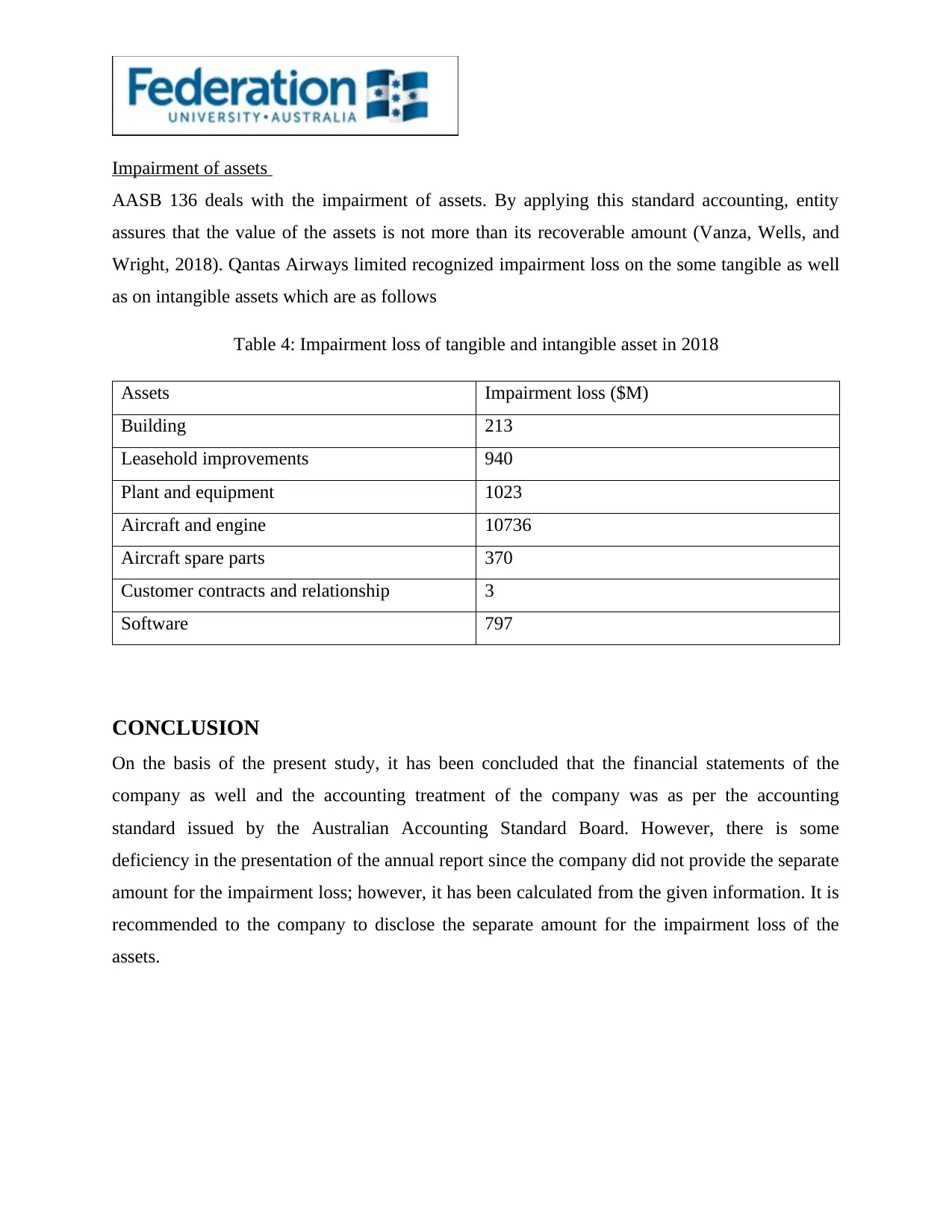
Impairment of assets
AASB 136 deals with the impairment of assets. By applying this standard accounting, entity
assures that the value of the assets is not more than its recoverable amount (Vanza, Wells, and
Wright, 2018). Qantas Airways limited recognized impairment loss on the some tangible as well
as on intangible assets which are as follows
Table 4: Impairment loss of tangible and intangible asset in 2018
Assets Impairment loss ($M)
Building 213
Leasehold improvements 940
Plant and equipment 1023
Aircraft and engine 10736
Aircraft spare parts 370
Customer contracts and relationship 3
Software 797
CONCLUSION
On the basis of the present study, it has been concluded that the financial statements of the
company as well and the accounting treatment of the company was as per the accounting
standard issued by the Australian Accounting Standard Board. However, there is some
deficiency in the presentation of the annual report since the company did not provide the separate
amount for the impairment loss; however, it has been calculated from the given information. It is
recommended to the company to disclose the separate amount for the impairment loss of the
assets.
AASB 136 deals with the impairment of assets. By applying this standard accounting, entity
assures that the value of the assets is not more than its recoverable amount (Vanza, Wells, and
Wright, 2018). Qantas Airways limited recognized impairment loss on the some tangible as well
as on intangible assets which are as follows
Table 4: Impairment loss of tangible and intangible asset in 2018
Assets Impairment loss ($M)
Building 213
Leasehold improvements 940
Plant and equipment 1023
Aircraft and engine 10736
Aircraft spare parts 370
Customer contracts and relationship 3
Software 797
CONCLUSION
On the basis of the present study, it has been concluded that the financial statements of the
company as well and the accounting treatment of the company was as per the accounting
standard issued by the Australian Accounting Standard Board. However, there is some
deficiency in the presentation of the annual report since the company did not provide the separate
amount for the impairment loss; however, it has been calculated from the given information. It is
recommended to the company to disclose the separate amount for the impairment loss of the
assets.
Paraphrase This Document
Need a fresh take? Get an instant paraphrase of this document with our AI Paraphraser
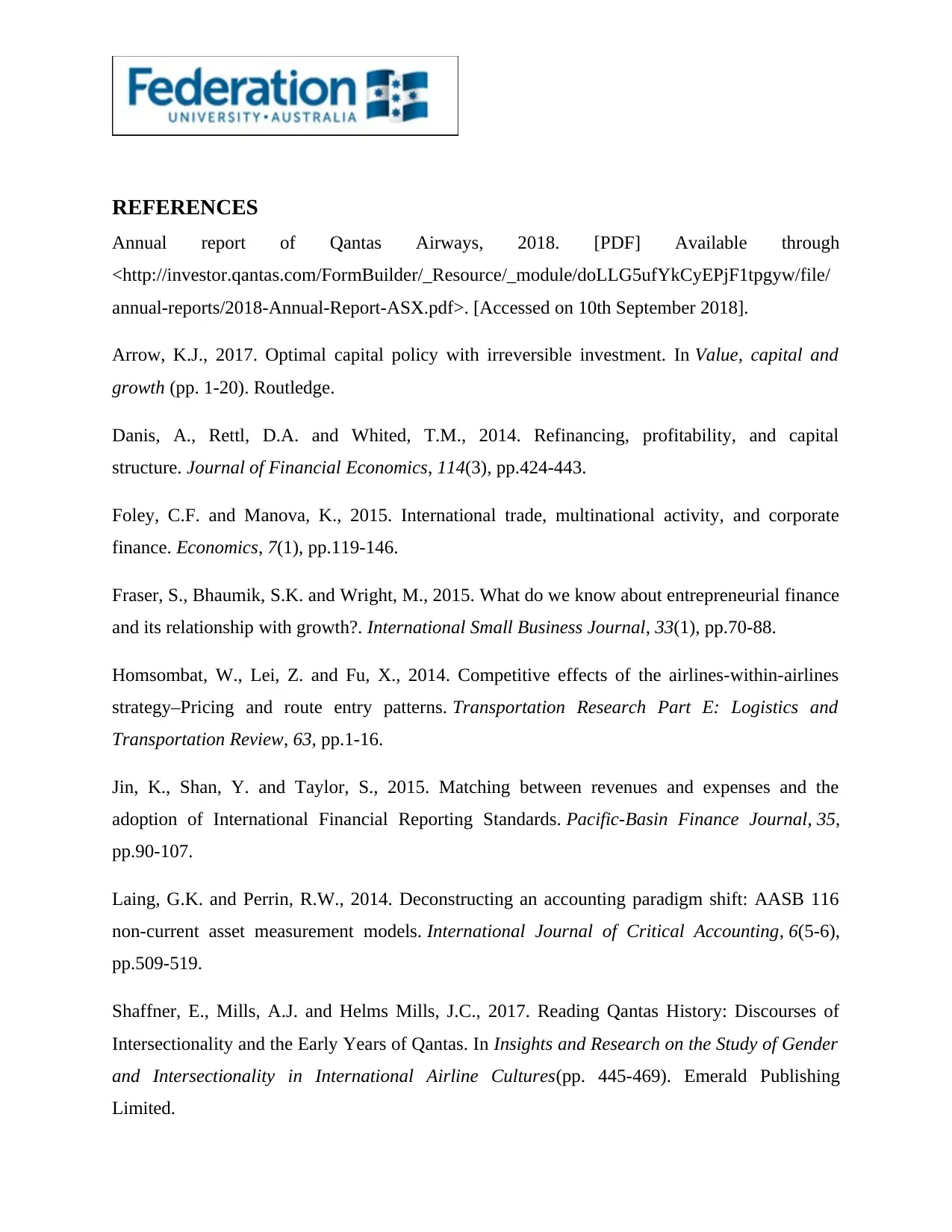
REFERENCES
Annual report of Qantas Airways, 2018. [PDF] Available through
<http://investor.qantas.com/FormBuilder/_Resource/_module/doLLG5ufYkCyEPjF1tpgyw/file/
annual-reports/2018-Annual-Report-ASX.pdf>. [Accessed on 10th September 2018].
Arrow, K.J., 2017. Optimal capital policy with irreversible investment. In Value, capital and
growth (pp. 1-20). Routledge.
Danis, A., Rettl, D.A. and Whited, T.M., 2014. Refinancing, profitability, and capital
structure. Journal of Financial Economics, 114(3), pp.424-443.
Foley, C.F. and Manova, K., 2015. International trade, multinational activity, and corporate
finance. Economics, 7(1), pp.119-146.
Fraser, S., Bhaumik, S.K. and Wright, M., 2015. What do we know about entrepreneurial finance
and its relationship with growth?. International Small Business Journal, 33(1), pp.70-88.
Homsombat, W., Lei, Z. and Fu, X., 2014. Competitive effects of the airlines-within-airlines
strategy–Pricing and route entry patterns. Transportation Research Part E: Logistics and
Transportation Review, 63, pp.1-16.
Jin, K., Shan, Y. and Taylor, S., 2015. Matching between revenues and expenses and the
adoption of International Financial Reporting Standards. Pacific-Basin Finance Journal, 35,
pp.90-107.
Laing, G.K. and Perrin, R.W., 2014. Deconstructing an accounting paradigm shift: AASB 116
non-current asset measurement models. International Journal of Critical Accounting, 6(5-6),
pp.509-519.
Shaffner, E., Mills, A.J. and Helms Mills, J.C., 2017. Reading Qantas History: Discourses of
Intersectionality and the Early Years of Qantas. In Insights and Research on the Study of Gender
and Intersectionality in International Airline Cultures(pp. 445-469). Emerald Publishing
Limited.
Annual report of Qantas Airways, 2018. [PDF] Available through
<http://investor.qantas.com/FormBuilder/_Resource/_module/doLLG5ufYkCyEPjF1tpgyw/file/
annual-reports/2018-Annual-Report-ASX.pdf>. [Accessed on 10th September 2018].
Arrow, K.J., 2017. Optimal capital policy with irreversible investment. In Value, capital and
growth (pp. 1-20). Routledge.
Danis, A., Rettl, D.A. and Whited, T.M., 2014. Refinancing, profitability, and capital
structure. Journal of Financial Economics, 114(3), pp.424-443.
Foley, C.F. and Manova, K., 2015. International trade, multinational activity, and corporate
finance. Economics, 7(1), pp.119-146.
Fraser, S., Bhaumik, S.K. and Wright, M., 2015. What do we know about entrepreneurial finance
and its relationship with growth?. International Small Business Journal, 33(1), pp.70-88.
Homsombat, W., Lei, Z. and Fu, X., 2014. Competitive effects of the airlines-within-airlines
strategy–Pricing and route entry patterns. Transportation Research Part E: Logistics and
Transportation Review, 63, pp.1-16.
Jin, K., Shan, Y. and Taylor, S., 2015. Matching between revenues and expenses and the
adoption of International Financial Reporting Standards. Pacific-Basin Finance Journal, 35,
pp.90-107.
Laing, G.K. and Perrin, R.W., 2014. Deconstructing an accounting paradigm shift: AASB 116
non-current asset measurement models. International Journal of Critical Accounting, 6(5-6),
pp.509-519.
Shaffner, E., Mills, A.J. and Helms Mills, J.C., 2017. Reading Qantas History: Discourses of
Intersectionality and the Early Years of Qantas. In Insights and Research on the Study of Gender
and Intersectionality in International Airline Cultures(pp. 445-469). Emerald Publishing
Limited.
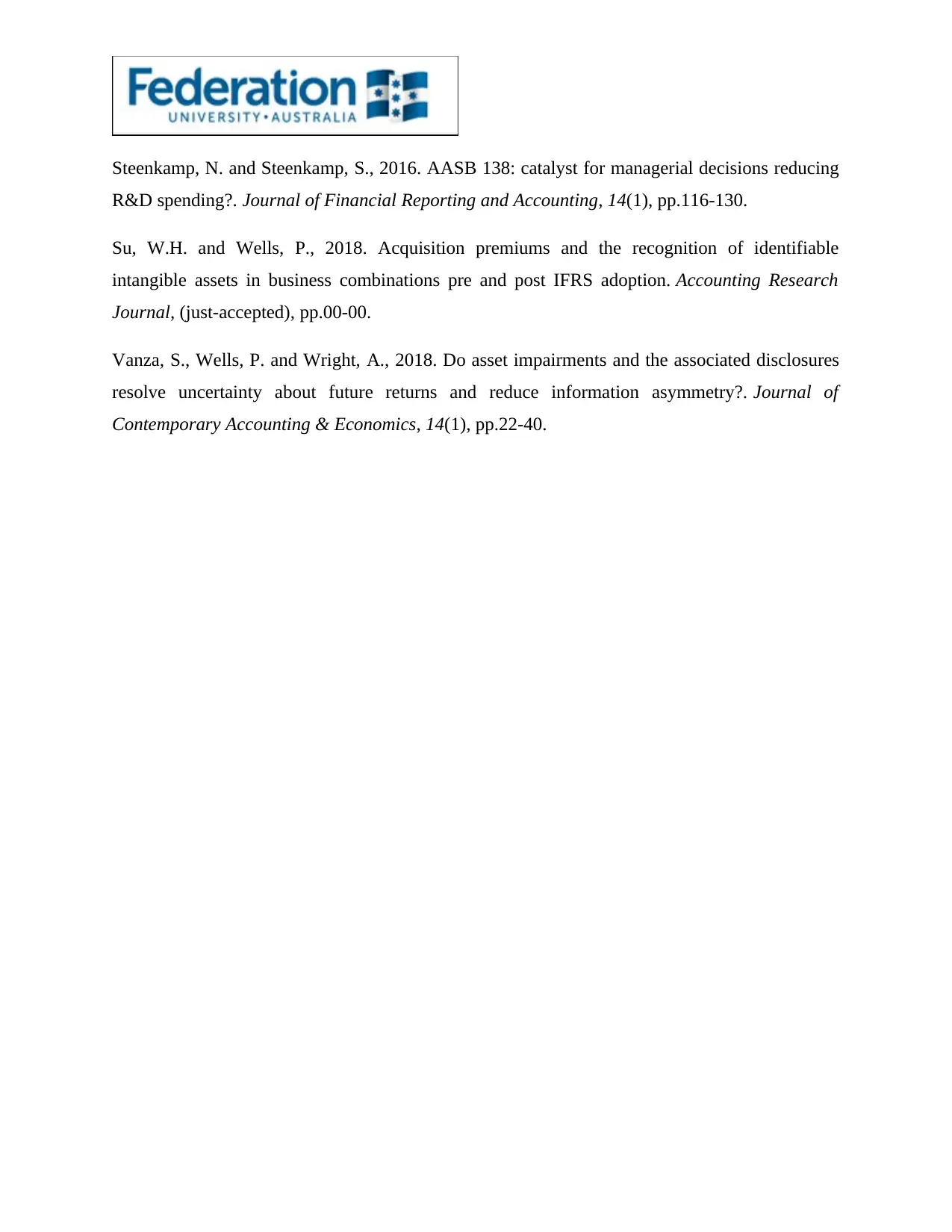
Steenkamp, N. and Steenkamp, S., 2016. AASB 138: catalyst for managerial decisions reducing
R&D spending?. Journal of Financial Reporting and Accounting, 14(1), pp.116-130.
Su, W.H. and Wells, P., 2018. Acquisition premiums and the recognition of identifiable
intangible assets in business combinations pre and post IFRS adoption. Accounting Research
Journal, (just-accepted), pp.00-00.
Vanza, S., Wells, P. and Wright, A., 2018. Do asset impairments and the associated disclosures
resolve uncertainty about future returns and reduce information asymmetry?. Journal of
Contemporary Accounting & Economics, 14(1), pp.22-40.
R&D spending?. Journal of Financial Reporting and Accounting, 14(1), pp.116-130.
Su, W.H. and Wells, P., 2018. Acquisition premiums and the recognition of identifiable
intangible assets in business combinations pre and post IFRS adoption. Accounting Research
Journal, (just-accepted), pp.00-00.
Vanza, S., Wells, P. and Wright, A., 2018. Do asset impairments and the associated disclosures
resolve uncertainty about future returns and reduce information asymmetry?. Journal of
Contemporary Accounting & Economics, 14(1), pp.22-40.
⊘ This is a preview!⊘
Do you want full access?
Subscribe today to unlock all pages.

Trusted by 1+ million students worldwide
1 out of 12
Related Documents
Your All-in-One AI-Powered Toolkit for Academic Success.
+13062052269
info@desklib.com
Available 24*7 on WhatsApp / Email
![[object Object]](/_next/static/media/star-bottom.7253800d.svg)
Unlock your academic potential
Copyright © 2020–2025 A2Z Services. All Rights Reserved. Developed and managed by ZUCOL.





